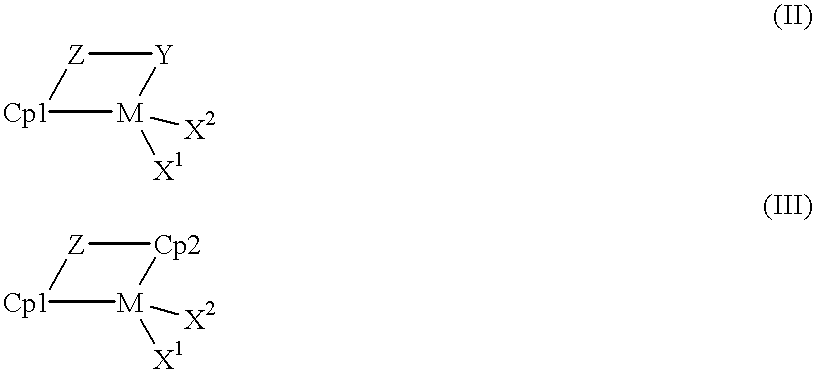Unsaturated copolymers, processes for preparing the same, and compositions containing the same
a technology of unsaturated copolymers and compositions, applied in the field of unsaturated copolymers, processes for preparing the same, and compositions containing the same, can solve the problems of reducing the properties of resins, reducing properties, and double bonds in the main chains of resins giving rise to oxidative deterioration, etc., to achieve excellent compatibility with other polar group-containing resins, excellent crosslinking efficiency and modification efficiency, and low glass transition temperature
- Summary
- Abstract
- Description
- Claims
- Application Information
AI Technical Summary
Benefits of technology
Problems solved by technology
Method used
Image
Examples
example a1
Pre-activation of Catalyst
In a glass vessel thoroughly replaced with nitrogen, 5.5 mg of (dimethyl(t-butylamide)(tetramethyl-.eta..sup.5 -cyclopentadienyl)silane)dichloride titanium synthesized by a known method was weighed. 0.75 ml of a 1.0 mmol / ml toluene solution of tri-isobutylaluminum (abbreviated to TIBA hereinafter), which was equal to 0.75 mmol of aluminum atom, was added to the vessel. Then the mixture was irradiated with ultrasonic waves at 23.degree. C. for 15 min, to prepare a catalyst solution.
Synthesis of Ethylene / butadiene Copolymer
To a 2 l autoclave dried under reduced pressure and replaced with nitrogen, 288 ml of toluene and 0.075 ml of the catalyst solution prepared in the above step of pre-activating catalysts were added at ordinary temperature, and ethylene was fed with stirring to elevate the pressure to 6 Kg / cm.sup.2 G. Thereafter the pressure of the autoclave was released. The pressuring and releasing procedure was repeated 3 times.
Thereafter, 7 g of a 1,3-bu...
example a2
The procedure of Example A1 was repeated except that the amount of 1,3-butadiene was changed to 10 g. The yield of the resulting ethylene / butadiene copolymer was 14 g, the intrinsic viscosity [.eta.], as measured in decalin at 135.degree. C. was 4.0 dl / g, the glass transition temperature Tg was -38.degree. C., the iodine value was 40 g / 100 g, the ethylene content was 91 mol %, the 5-membered ring structure was 6.8 mol %, the cyclopropane ring structure was 0.1 mol %, the 1,2-addition structure was 0.6 mol %, the 1,4-addition structure was 1.5 mol % and the activity was 112 Kg / mmolZr.multidot.hr.
The results are shown in Table 4.
example a3
The procedure of Example A1 was repeated except that the amount of 1,3-butadiene was changed to 4 g. The yield of the resulting ethylene / butadiene copolymer was 15 g, the intrinsic viscosity [.eta.], as measured in decalin at 135.degree. C. was 4.2 dl / g, the glass transition temperature Tg was -40.degree. C., the iodine value was 21 g / 100 g, the ethylene content was 97 mol %, the 5-member ring structure of 1.9 mol %, the cyclopropane ring structure was 0.1 mol %, the 1,2-addition structure was 0.4 mol %, the 1,4-addition structure was 0.6 mol % and the activity was 120 Kg / mmolZr.multidot.hr.
The results are shown in Table 4.
PUM
| Property | Measurement | Unit |
|---|---|---|
| Angle | aaaaa | aaaaa |
| Angle | aaaaa | aaaaa |
| Angle | aaaaa | aaaaa |
Abstract
Description
Claims
Application Information
 Login to View More
Login to View More - R&D
- Intellectual Property
- Life Sciences
- Materials
- Tech Scout
- Unparalleled Data Quality
- Higher Quality Content
- 60% Fewer Hallucinations
Browse by: Latest US Patents, China's latest patents, Technical Efficacy Thesaurus, Application Domain, Technology Topic, Popular Technical Reports.
© 2025 PatSnap. All rights reserved.Legal|Privacy policy|Modern Slavery Act Transparency Statement|Sitemap|About US| Contact US: help@patsnap.com



